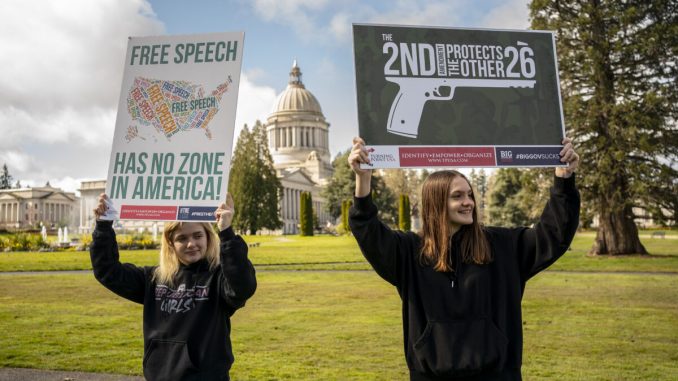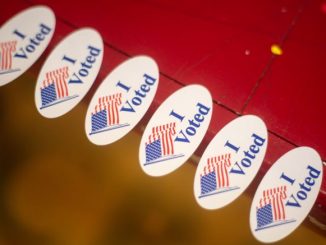

Commentary
This is the seventh installment in a series defending the Constitution against slanders from “progressive” critics.
A lawyer in Boulder, Colorado, has been buying billboard space attacking the Second Amendment right to keep and bear arms.
One billboard reads:
IMAGINE HIGHWAYS USING TRAFFIC LAWS WRITTEN IN 1791.
IMAGINE RADIO, TELEVISION, AND INTERNET RUN BY 1791 REGULATIONS.
IMAGINE LIMITING YOURSELF TO MEDICAL CARE AVAILABLE IN 1791
THE SECOND AMENDMENT WAS WRITTEN IN 1791
THOUGHTS AND PRAYERS ARE NOT ENOUGH
This Ad Paid For by Lindasue Smollen
****
If you get angry reading Lindasue Smollen’s billboard message, please leave her alone. She has a right to freedom of speech and of the press. They are guaranteed to her by the First Amendment—also adopted in 1791. (Because she’s using a medium, a billboard, to communicate her message, her conduct is more properly an expression of freedom of the press than freedom of speech.)
My first reaction to this billboard was that Smollen was wasting her money: A key to effective billboard advertising is brevity. Drivers don’t have time to read lengthy messages.
But it turned out that she didn’t waste her money, because the liberal media megaphone did her work for her. It dutifully reproduced her billboard and its messages to the wider American public.
Have you ever seen mainstream media repeating any of the conservative, patriotic, pro-life, or religious billboards appearing on our highways? Of course not.
My second, probably sounder, reaction was that maybe Smollen should sue for a law school tuition refund. Obviously she was never taught the difference between ordinary legislation (such as traffic laws) and a general constitutional standard. Law professors traditionally employ Chief Justice John Marshall’s famous opinion in McCulloch v. Maryland (1819) to explain the distinction. But apparently at her law school they neglected to do so.
For those of you who didn’t attend a competent law school, here’s the distinction: Ordinary legislation (such traffic laws) are detailed to respond to specific conditions. The legislature readily alters them when necessary. But while constitutions often contain detailed provisions, they also feature many terms (such as the Second Amendment) written in broader, more enduring language. As Chief Justice Marshall explained in the McCulloch case, we interpret broad constitutional standards somewhat differently from ordinary laws. “[W]e must never forget,” he wrote, “that it is a constitution we are expounding.”
Unlike traffic rules, the Constitution’s expansive provisions are crafted to accommodate changing conditions. For example, the Commerce Clause (Article I, Section 8, Clause 3) doesn’t lay out detailed rules for trade by horse, ship, and barge. Rather, it grants Congress power to regulate Commerce. That word “commerce” enables Congress to regulate trade by methods that didn’t exist when the Constitution was adopted, such as railroads, motor vehicles, aircraft, and telecommunications.
Similarly, the Second Amendment doesn’t protect “the right of the people to keep and bear muskets and swords.” It protects the right to “keep and bear Arms.” That’s why the Second Amendment protects the right to own and use modern “bearable” (portable) weapons, such as semi-automatic AR-15 style rifles.
In short, by comparing traffic laws to the Second Amendment, Smollen’s billboard compares apples to edibles.
The billboard message also suffers from the false assumption that changes in conditions necessarily require changes in the Constitution. Because of the breadth of constitutional language, this simply isn’t true.
In 2011, Time Magazine ran a front page editorial that remains one of my favorite samples of constitutional illiteracy. The editorial sought to discredit the Constitution by pointing out that the Founders didn’t know about—
“World War II. DNA. Sexting. Airplanes. The atom. Television. Medicare. Collateralized debt obligations. The germ theory of disease. Miniskirts. The internal combustion engine. Computers. Antibiotics. Lady Gaga.”
The author was right that the Founders didn’t know about those things. But sexting, miniskirts, and Lady Gaga (as important as they may seem to a trendy magazine editor) aren’t the sort of things that justify constitutional change.
A change in conditions merits a change in a constitutional phrase only if—
- The change is relevant to the constitutional phrase; and
- Knowledge acquired since the Constitution was adopted (including knowledge of the change) has destroyed the phrase’s value.
Consider relevance first: The Second Amendment was adopted partly to protect state militias. But it also was adopted to enable citizens to protect themselves against criminals, foreign invaders, and domestic tyrants. Traffic laws, radio, television, the internet, and modern medicine don’t undercut any of the reasons behind the Second Amendment.
On the contrary, you can argue that social changes call for strengthening the Second Amendment. Modern American cities probably suffer more violent crime than in 1791, rendering self-defense and arms training for law-abiding citizens more vital. Modern medicine makes it easier to remedy accidents arising from the legitimate use of weapons.
What about knowledge acquired since 1791?
We know that criminals sometimes use weapons to attack others and that armed citizens can stymie those attacks. But the Founders knew those facts, too. Recent international experience tells us that an armed citizenry can help resist foreign invasions and domestic tyrants. But the Founders knew that as well.
However, we have learned two lessons outside the Founders’ immediate experience. One is that even governments in “civilized” countries may slaughter their own people, and that they can do so only when the targeted portion of the citizenry is disarmed. The 20th century history of Germany is a case in point. The other recent lesson, as my Independence Institute colleague Dave Kopel has documented, is that America isn’t immune to terrorism against unarmed populations. The history of the Ku Klux Klan is a case in point.
So it’s clear that the Founders were right to adopt the Second Amendment. It’s even clearer that we need its protection today.
Robert G. Natelson is a former constitutional law professor, senior fellow in constitutional jurisprudence at the Independence Institute in Denver, and author of “The Original Constitution What It Actually Said and Meant“ (3rd ed., 2014). His work has never been funded by any organization on either side of the gun control debate.
Views expressed in this article are the opinions of the author and do not necessarily reflect the views of The Epoch Times.






Be the first to comment